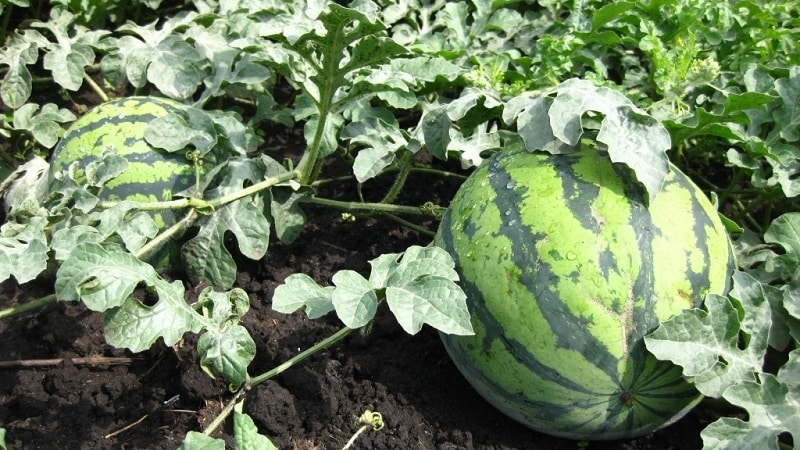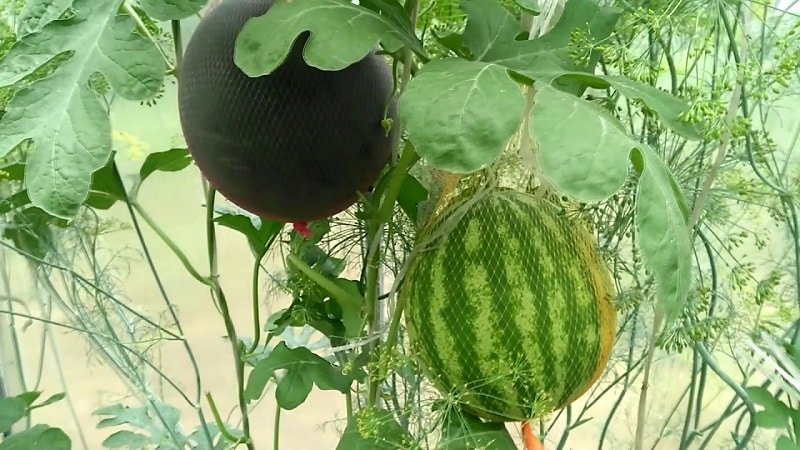Step-by-step instructions for growing watermelons in the Moscow region in open ground
Sweet juicy watermelon pulp is a fragrant and healthy summer dessert. Both children and adults love him. However, when buying watermelon at the market or in a store, you cannot be completely sure of the quality of the product. It is not surprising that more and more gardeners are growing these delicious fruits in their dachas.
The achievements of modern selection make it possible to cultivate watermelons in open ground not only in the south, but also in other regions of our country. From the article you will learn about growing watermelons in the Moscow region in open ground.
Features of growing watermelons in the Moscow region in open ground
How to grow delicious juicy watermelons in the Moscow region? Taking into account the short and often cool summers, it is preferable to grow melons in the Moscow region through seedlings. This technique will speed up the harvest by several weeks.

Weather
There are few truly hot summer days in the Moscow region. In June, although the air warms up during the day to an average of +20°C, there are often recurrent frosts and prolonged rains.
In July, the average daily temperature is higher. At times the air warms up to +35°C during the day. But such days are few.
In August the days are warm, but the nights become colder. The number of cloudy days and precipitation increases, and the length of daylight hours decreases.
Thus, the weather conditions of the Moscow region are not optimal for growing in open ground such a heat-demanding southern crop as watermelon.
Nevertheless, breeders have developed varieties and hybrids that can be successfully grown in such conditions. Of course, subject to compliance with agricultural technology.
Suitable varieties of watermelons
Growing watermelons begins with the right choice of variety. For the Moscow region, early ripening varieties and hybrids of the crop are chosen. At the same time, they must be relatively resistant to temperature changes. The fruits of such varieties are not large in size, but in other characteristics, watermelons are not much different from their southern counterparts.
Among the popular early watermelons are the hybrids Podmoskovny Charleston F1, Orange Medok F1, Kai F1, Pink Champagne F1 and varieties Ogonyok, Ultra early, Crimson Sweet, Siberian lights, Sugar baby, Skorik.
Growing instructions
Watermelon is a southern crop that loves sunshine and warmth. Therefore, seedlings are planted in open ground only after the soil has warmed up well. The soil temperature must be at least +15°C.
When using the seedling method, the seeds are sown in late April-early May. Plants are planted in the garden a month after sowing.

Preparatory stage
This stage consists of preparing the soil and seed material.
For watermelons, choose an open sunny area. Unfavorable predecessors for melons are legumes and cabbage. Desirables: potatoes, onions, tomatoes.
Important! Watermelons do not grow well in acidic soil.
In the fall, the garden bed is dug up, cleared of weeds, and fertilizers, compost, and humus are added. If the soil is acidic, add slaked lime, dolomite, wood ash and ground chalk.
Seed preparation
Preparing seeds for landing accelerates the emergence of seedlings.The seeds are wrapped in paper or cloth and kept in warm water until they bite.
Treating seeds helps protect young plants from diseases. To do this, they are kept for half an hour in a solution of potassium permanganate, and then washed with clean water.
Growing seedlings
Sprouted seeds are planted in separate containers filled with soil to 2/3 of the volume. Then the elongated sprouts can be sprinkled with soil, and they will give additional roots.
Advice. Choose individual glasses for seedlings with a volume of at least 0.3-0.5 liters.
Watermelons do not like transplanting. Peat or plastic cups with a diameter of at least 15 cm are ideal for plants.
The seeds are placed in glasses and buried 2 cm. The top layer of soil is slightly compacted. The land is well watered. After this, the glasses are transferred to a warm, sunny place.
Plants are transplanted to a permanent location when they grow 2-3 leaves. A few days before planting, the seedlings are hardened off by gradually lowering the air temperature.
Planting in open ground

Watermelons are transplanted into the garden in early June, when the threat of cold weather has passed. When using shelters, seedlings are planted earlier, starting 3 weeks after sowing the seeds.
The seedlings are transplanted into prepared holes, after thoroughly moistening the bottom of the hole. The distance between holes is determined based on the recommendations of the seed manufacturer. The earth ball is not buried; it should rise 1-2 cm above the soil surface.
Attention. Deepening the earthen ball when planting seedlings leads to rotting of the root collar.
Care
The planted seedlings are protected from temperature changes and cold winds with film. The shelter is constantly ventilated to avoid the formation of condensation.The protective shelter is removed with the arrival of real warmth.
Watering
The watermelon bed is watered about once a week. When watering, avoid getting moisture on the foliage and vines. Using a layer of mulch reduces the amount of watering and loosening. In addition, mulch increases the temperature of the soil at the surface.
During the flowering period, plants are watered less frequently, approximately once every two weeks. Watering is stopped during fruit filling and ripening.
Feeding
Approximately 20 days after planting the seedlings, fertilizing is applied. As a fertilizer, use a solution of ammonium nitrate (at the rate of 20 g per 1 bush), or complex fertilizers in accordance with the manufacturer’s recommendations. During the budding period, fertilizers are applied again.
Topping
Pinching watermelon vines is an important agricultural technique that allows you to speed up the ripening of fruits in the short summer near Moscow.
Pinching begins with the removal of side shoots. From 4 to 6 fruits are left on the main lash, after which it is also pinched.
The vine is cut off, leaving 4-5 leaves after the last fruit. These leaves help the bush receive adequate nutrition.
As they grow, new vines grow on the bushes. They are also pruned, periodically inspecting all the bushes.
Possible problems and solutions

When growing watermelons in the Moscow region, gardeners are faced with melon diseases and pest damage to the plantings.
Diseases
Watermelon bushes are affected by diseases such as anthracnose, fusarium, and powdery mildew.
Anthracnose is a fungal disease that affects leaves, stems and the fruits themselves. The fungus is dangerous because it leads to the complete death of the bush. The development of the disease is provoked by excessive moisture in the soil and air.
Fusarium is a fungal disease that affects leaves and canes.The disease causes greenery and stems to wilt. The fungus enters the plant through the root system. Gradually the stems become thinner and darker. The risk of infection increases with excessive watering.
Powdery mildew - another fungal disease. The disease is recognized by white spots on the leaves. Plants affected by the fungus shrink and dry out, and the formed fruits stop growing and filling.
If a fungal disease is detected, the affected parts of the bush are removed and burned. The remaining plants are sprayed with fungicides. The solution is prepared in accordance with the recommendations of the drug manufacturer. Spraying is stopped three weeks before harvest.
Pests
Melon aphids, wireworms, meadow moths, and cutworms are dangerous for watermelon beds. If insects are detected, the bushes are treated with biological products or chemical insecticides.
Traditional methods of control include spraying bushes with an infusion of ash, onion peels, and garlic. The bushes most affected by parasites are removed and burned.
Preventive measures
The occurrence and development of diseases will be prevented by compliance with growing conditions and the selection of varieties resistant to diseases.
Important! Thickening of plantings is one of the main reasons why watermelons are affected by fungal diseases.
Preventive measures include treating seeds and soil with biofungicides before planting, maintaining the required distances between plants when planting seedlings, clearing the area of plant debris in the fall, and timely application of fertilizers.
Harvesting

The harvest is harvested in several stages as the fruits ripen. Watermelons, unlike melons, do not ripen well during storage, so they are harvested when the flesh has already turned pink and the seeds have acquired a characteristic color.
Fully ripened watermelons also do not have good shelf life. A month after being removed from the garden, the pulp of the fruit softens.
The ripeness of a watermelon is determined by external signs. In a mature fruit, the stalk and tendrils near it dry out. The bark becomes shiny, elastic, and the color becomes intense. A large yellow spot forms on the crust on the ground side. When tapped, the ripe fruit produces a dull sound.
Ripe watermelons are cut from the stem with a knife, leaving a tail about 5 cm long. If the tail is broken off, the fruit quickly rots.
Watermelons are delivered to the storage location in containers or on pallets. They are lined with straw or shavings. The same materials are used to lay the rows of watermelons themselves. You can transport watermelons without any container, laying them out in one row on a straw bed.
Advice from experienced farmers
For those who are just starting to grow watermelons, the following advice from experienced farmers will help:
- in short and cool summer conditions, it is preferable to grow melons, including watermelons, in warm beds - then the plants will be healthier and the fruits will ripen earlier;
- the formation of watermelon bushes speeds up the harvest - if the side vines are not pinched, the fruits will be small and will not have time to ripen;
- when planting seedlings, it is important to maintain the recommended distance between plants - thickening of plantings inhibits the growth of the bush and contributes to the development of diseases;
- After the fruits have formed, it is good to place boards or other suitable material under them - this way you will prevent spoilage and rotting of the watermelons.
Conclusion
Cultivating heat-loving southern watermelons in the climate near Moscow is not an easy task. A competent approach to choosing a variety, using the seedling method of growing and following the rules of care will help solve it.By following the recommendations of experienced farmers, it is quite possible to grow a good harvest of sweet and aromatic watermelons on your plot.